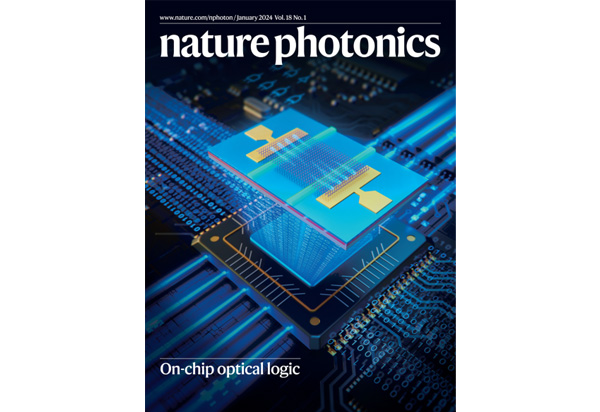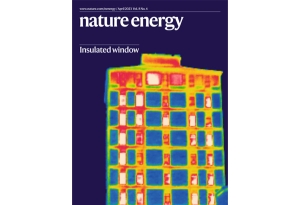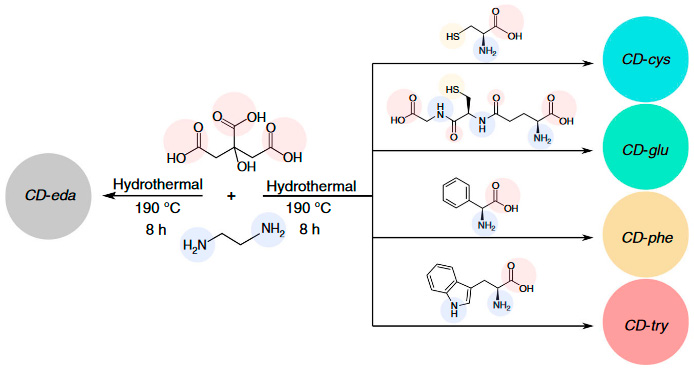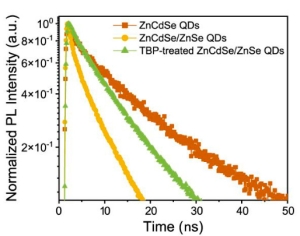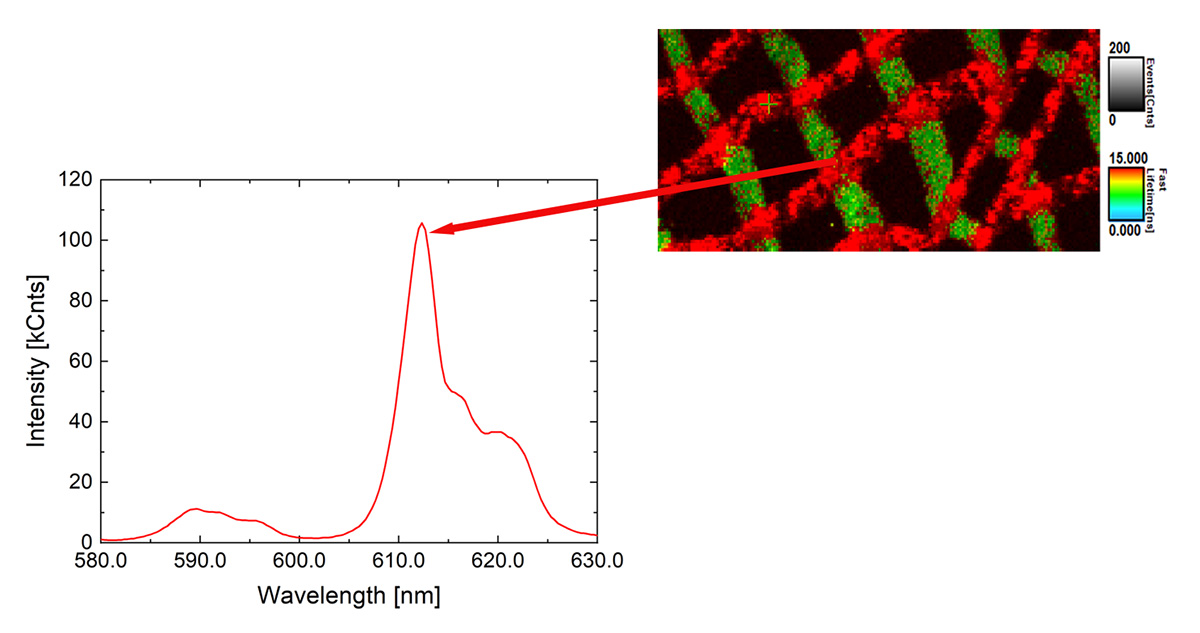Fluorescence Microscopes
MicroTime 100
Compact Upright Photoluminescence Microscope
- Confocal time-resolved photoluminescence microscope with single photon detection sensitivity
- Based on time-correlated single photon counting (TCSPC)
- Lifetime detection range of a few ps to several ms with ps timing resolution
- Broad excitation wavelengths from 375 to 1060 nm
- Detection range from 400 nm to 1050 nm
- Intuitive data acquisition and powerful analysis with SymPhoTime 64 software
Upgrades:
- Spectrally resolved measurements via photoluminescence spectrometer (FluoTime 300, FluoTime 250) coupling or with the new FlexLambda add-on
- CCD-based spectograph
- Charge carrier diffusion upgrade
- Superconducting Nanowire Single-Photon Detector (SNSPD)
- Heating stage
- Cryostat
MicroTime 100 is a compact and flexible confocal microscope. It is an ideal time-resolved photoluminescence imaging setup for various materials science applications including solar cells, light emitting diodes (LEDs), single emitters characterization, and in general semiconductor research. MicroTime 100 is based on a conventional upright microscope body (BX43) that permits easy access to a wide range of sample shapes and sizes. For further flexibility, a BXFM body together with a specialized stand can be employed.
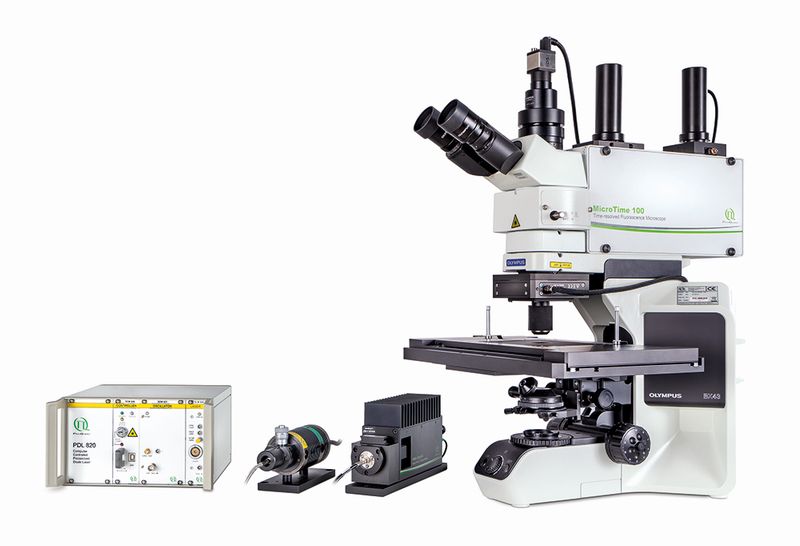
This confocal microscope is designed to be equipped with PicoQuant picosecond pulsed light sources, Time-Correlated Single Photon Counting (TCSPC) electronics and single photon sensitive detectors. This combination enables photoluminescence lifetime detection down to a few ps and up to several ms. All components are being controlled by SymPhoTime 64 software which is a powerful analysis software. Numerous measurements can be carried out using MicroTime 100 such as
- Time-resolved photoluminescence (TRPL)
- TRPL imaging
- Fluorescence Lifetime Imaging (FLIM)
- Phosphorescence Lifetime Imaging (PLIM)
- Charge carrier diffusion imaging
- Single Molecule Detection (SMD)
- Photon bunching and antibunching
- Förster Resonance Energy Transfer (FRET)
MicroTime 100 can be coupled with PicoQuant photoluminescence spectrometers as well as spectrograph enabling multimodal imaging where spectral and temporal information can be collected from the solid samples at high spatial resolution.
Recent publications by researchers using the MicroTime 100
Scientific guidance and user training
 PicoQuant annually holds the European short course on "Time-resolved Microscopy and Correlation Spectroscopy". The course is intended for individuals wishing an in-depth introduction to the principles of time-resolved fluorescence microscopy and its applications to the Life Sciences. This 3-day event consists of lectures as well as instrumentation and software hands-on training.
PicoQuant annually holds the European short course on "Time-resolved Microscopy and Correlation Spectroscopy". The course is intended for individuals wishing an in-depth introduction to the principles of time-resolved fluorescence microscopy and its applications to the Life Sciences. This 3-day event consists of lectures as well as instrumentation and software hands-on training.
Detailed specifications are included in the MicroTime 100 datasheet.
| Microscope |
|
| Excitation Sources |
|
| Detectors |
Up to four parallel detection channels |
| Data Acquisition |
Accessible lifetime ranges from < 30 ps to > 5 ms Based on Time-Correlated Single Photon Counting (TCSPC) and Multi-Channel Scaling (MCS) measurement mode Simultaneous data acquisition of up to four detection channels |
| Software |
SymPhoTime 64 |
All Information given here is reliable to our best knowledge. However, no responsibility is assumed for possible inaccuracies or omissions. Specifications and external appearances are subject to change without notice.
 Add-on: FlexLambda Wavelength Selection Unit for Confocal Microscopes
Add-on: FlexLambda Wavelength Selection Unit for Confocal Microscopes
Feature highlights:
- Spectral scanning with > 80 % transmission from 400 to 1000 nm for highest sensitivity
- High temporal resolution without pulse broadening by an optical diffraction grating
Suitable for various applications:
- Materials Sciences: time-resolved and spectrally resolved microscopic characterization of solar cells and photovoltaics, LEDs and OLEDs, nanoparticles and 2D materials
- Measure photoluminescence spectrum at a point of interest in sample
- TRES imaging: measure TRPL images at defines emission wavelengths
- Measure wavelength-dependent antibunching
Specifications:
- Spectral range: 400 - 1000 nm
- Transmission: > 80 % over the whole spectral range
- Bandwidth min.: 1 nm
- Bandwidth max.: 100 nm
- Step width min: 0.1 nm
- Detection: single detector directly mounted or fiber-coupled multi-channel detection unit
- Detector types: PMA Hybrid series or SPADs
- Software: SymPhoTime 64
Detailed specifications are included in the Datasheet Wavelength Selection Unit FlexLambda.
- Solar Cell and Photovoltaics Research
- Characterization of Light Emitting Diodes (LEDs)
- Research of Nanoparticles and TMDs
- Antibunching
- Characterization of semiconductors
The following documents are available for download:
- Datasheet MicroTime 100
- Datasheet Wavelength Selection Unit FlexLambda
- Technical note: Time-Correlated Single Photon Counting (TCSPC)
- Application Note: Time-resolved Fluorescence Spectroscopy and Microscopy in Materials Science
- Poster: Quick Reference for confocal time-resolved microscopy (FLIM, FRET, FCS)
- MicroTime 100 broschure
Latest 10 publications referencing MicroTime 100
The following list is an extract of 10 recent publications from our bibliography that either bear reference or are releated to this product in some way. Do you miss your publication? If yes, we will be happy to include it in our bibliography. Please send an e-mail to info@picoquant.com containing the appropriate citation. Thank you very much in advance for your kind co-operation.




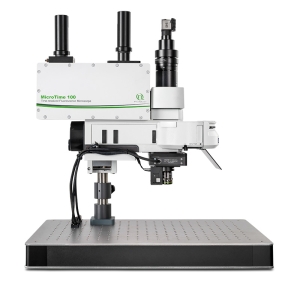
 Contact us
Contact us